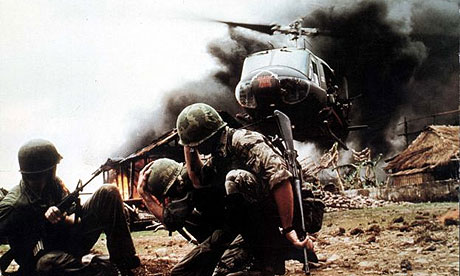http://www.guardian.co.uk/film/2008/oct/17/1
Coppola's slow boat on the Nung
Gordon Coates on the five-hour Apocalypse Now
- Gordon Coates The Guardian, Friday October 17 2008

The long and the short of it ... Francis Ford Coppola's Apocalypse Now. Photograph: Ronald Grant Archive
The work print is the holy grail of film collecting. These are the vastly long, rough versions of a picture, containing much of the movie-making fat that is trimmed out by the editing process. For years, film collectors tap their keyboards until their fingers bleed in attempts to track down the bum-numbing versions of movies such as Dune and This Is Spinal Tap for the unseen gems they may or may not hold.
Of all the legendary work prints out there, the most persistently tantalising prospect is seeing the rumoured 289-minute version of Francis Ford Coppola's Apocalypse Now. The theatrical release print runs a mere 153 minutes, and the Redux reissue 202 minutes, so the work print offers almost an hour and a half of unseen footage. To a serious film geek, the prospect is unthinkably exciting - surely it couldn't be true?
Despite a lack of tangible proof that it even existed - including denials from the film's producers - the most dedicated collectors spent years searching for it, until something supposed to be this grail-like object found its way into the public domain. After exhaustive negotiations with an American film collector who had tracked down a copy, I found myself signing for an airmail package, booking the day off work and settling down for some serious viewing.
The first thing to point out is that to call this five-hour work print a "rough cut" is a mistake. It's an "everything-and-the-kitchen-sink" cut, which takes almost all the material from the 238-day shoot and tapes it together in a linear form. The work print moves at a snail's pace, with unfeasibly long scenes. The Ride of the Valkyries helicopter episode alone accounts for well over 30 minutes of footage. Scenes that, with expert editing, would become tense and compelling simply drift along aimlessly, interesting only to anoraks for the extra line of dialogue here and there.
There are, however, gems amid the mass of footage, which leave the viewer wondering how Coppola could have taken the scissors to them. Marlon Brando's Colonel Kurtz has three extra scenes, which more than quadruple the size of his part. In one, Brando reads from Time magazine to an imprisoned Martin Sheen. In another he delivers a monologue to Sheen about the "master liars" in Washington who "want to win, but can't stand to be thought of as cruel". In a third, he reads TS Eliot's The Hollow Men, while Dennis Hopper gets excited and says "man" a lot.
One of the things removed from the film for the cinematic release, along with the extra footage, is its political conscience. Scenes in which the characters question and criticise the US involvement in Vietnam and the conduct of American government are cut. Themes of politics give way to an exploration of the human nature and psychology.
Of all the cuts, the unkindest are dealt to Scott Glenn's character, Colby, Willard's predecessor, who was charged with killing Kurtz, but instead falls under his spell. In the work print, Colby is revealed to be a significant character who taunts an imprisoned Willard and, more importantly, shoots Hopper's character before being killed himself. Likewise, the character of Lance (played by Sam Bottoms) gets extra scenes designed to show his instability. In one, he inexplicably machine-guns a water buffalo, while screaming: "I control the destiny of every living thing which passes before my sights."
It took Coppola and his editors more than 700 days to turn a million feet of celluloid into a watchable film. What the work print makes clear are the choices editors are forced to make when faced with almost unlimited footage. Scenes that drove the crew to the brink of madness and Coppola to the edge of financial ruin were dropped without sentiment - simply because they didn't improve the story.
http://www.guardian.co.uk/film/2008/nov/01/apocalypse-now-holy-grail-letters
- The Guardian, Saturday November 1 2008
Letter: Apocalypse Now and the holy grail
Gordon Coates (Coppola's slow boat on the Nung, Film & Music, October 17) referred to the "holy grail" of film collecting as a "rumoured 289-minute version of Francis Coppola's 1979 film Apocalypse Now", adding that the film's producers denied the existence of this long version. In reality, it comes down to semantics. When the film-makers returned from their 238-day shoot, the editors put together a rough assembly that ran to nearly five hours, and contained all the scenes that had been shot. So when one heard "there is no five-hour version", the producers were not being evasive. It is not a version of a film, it is a catalogue of everything, which then had to be edited into a coherent narrative.
In 1999 Coppola decided to revisit the raw material to create a new version that would be more faithful to his original vision. Apocalypse Now Redux was screened at Cannes in May 2001 and had a theatrical release later that year.
In that long first assembly is the scene in which Kurtz is reading from Time magazine. It was restored, recut and included in the Redux version, along with several other scenes. Brando's reading of Eliot's The Hollow Men can be seen in its entirety as a special feature in the special two-DVD release, Apocalypse Now (Steelbook Edition).
Many significant scenes that were neither in the original nor the Redux version are in the Steelbook version. They include scenes with Willard's special ops predecessor Colby, and the death of the foreign correspondent played by Dennis Hopper. It also includes audio commentaries by the director in which he addresses the editing decisions he faced in the 70s and again in 2000-01.
Kim Aubry
Co-producer of Apocalypse Now Redux



No comments:
Post a Comment